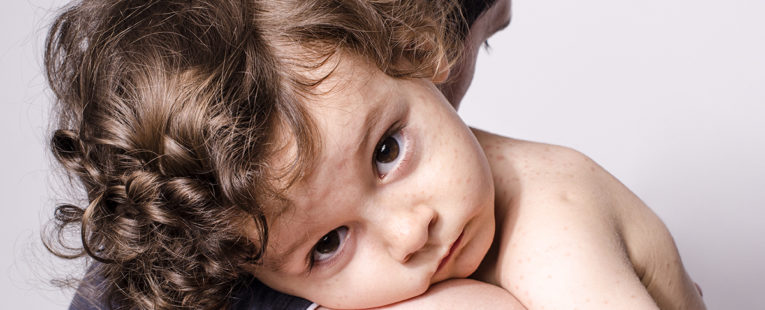You might have heard a lot about measles, but separating fact from fiction can be difficult in the age of social media.
Here’s what you should know about the disease.
What is measles?
 Measles, also called rubeola, is an illness caused by a virus. It’s usually marked by a rash and fever that clears up within a few days, but measles can cause serious health complications, especially in very young children.
Measles, also called rubeola, is an illness caused by a virus. It’s usually marked by a rash and fever that clears up within a few days, but measles can cause serious health complications, especially in very young children.
“When you first start to show symptoms, they can be very mild – a mild fever, runny nose, red eyes, cough and little white spots in your mouth, alongside your cheek. You can then develop a very high fever and a rash that starts on the head and face then spreads down the body. The rash is the classic symptom everyone is familiar with,” said Lori Grooms, OSF HealthCare director of infection control and prevention.
“But measles can be very serious, especially for children under 5 years of age and adults over 20 years old.”
According to the Centers for Disease Control and Prevention:
- About 1 in 4 people in the U.S. who get measles will require hospitalization
- About 1 in every 1,000 will develop brain swelling, which could cause permanent brain damage
- 1 to 2 out of 1,000 people with measles will die, even after receiving appropriate care
How does measles spread?
Measles spreads through the air when an infected person coughs or sneezes. Measles is considered highly contagious, and an unprotected person has about a 90 percent chance of contracting the disease if they are exposed to it.
Because the virus can live in the air for up to two hours, an infection can spread from person to person even if they aren’t in a room together at the same time. Additionally, an infected person can be contagious for several days before they show any symptoms of disease. For these reasons, measles spreads very quickly among unprotected populations.
How can I protect myself and my child from measles?
 Measles can be prevented with the MMR vaccine, which protects against measles, mumps and rubella.
Measles can be prevented with the MMR vaccine, which protects against measles, mumps and rubella.
The CDC recommends children get two doses of MMR vaccine: the first between the ages of 12 to 15 months and the second between ages 4 and 6 years.
Despite concerns, research shows that the vaccine is safe and up to 97 percent effective at preventing the spread of disease.
“Since the discovery of vaccinations, many diseases once considered to be very dangerous have decreased in recent years. Many physicians today have never seen cases of measles, mumps, polio or other communicable diseases,” Grooms said. “Because of this many parents today grew up in an era when these diseases were unseen and are unaware of the complications they can cause.”
As a result, more parents have chosen not to vaccinate their children. With this decline in vaccination rates, we have seen an increase in the number of cases of these diseases over the past several years, which could have been prevented through vaccination.
“Vaccination really is the safest way to protect both your children and the public at large. Many of the vaccine preventable diseases can cause lifelong complications or even death. The safety and efficacy of vaccines has improved over the years and the benefits of vaccines outweighs the risks associated,” Grooms said.
